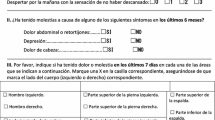Abstract
The Revised Fibromyalgia Impact Questionnaire (FIQR) attempts to address the limitations of the Fibromyalgia Impact Questionnaire (FIQ). As there is no Turkish version of the FIQR available, we aimed to investigate the validity and reliability of a Turkish translation of the FIQR in Turkish female fibromyalgia (FM) patients. After translating the FIQR into Turkish, it was administered to 87 female patients with FM. All of the patients filled out the questionnaire together with a Turkish version of the FIQ, hospital anxiety and depression scales (HADS), short form-36 (SF-36). The tender-point count (TPC) was also calculated from tender points identified by thumb palpation. One week later, FM patients filled out the Turkish FIQR at their second visit. The test–retest reliability of the Turkish FIQR questions ranged from 0.714 to 0.898. The test and retest reliability of total FIQR score was 0.835. Cronbach's alpha was 0.89 for FIQR visit 1 (the first assessment) and 0.91 for FIQR visit 2 (the second assessment), indicating acceptable levels of internal consistency for both assessments. The total scores of the FIQR and FIQ were significantly correlated (r = 0.87, P < 0.01). Significant correlations for construct validity were also obtained between the FIQR total and domain scores and the FIQ, the HADS and the subscales of the SF-36 (FIQR total versus SF-36 physical component score and mental component score were r = −0.63, P < 0.01 and r = −0.51, P < 0.01, respectively). The Turkish FIQR is a reliable and valid instrument for measuring health status in FM, showing sufficient reliability and construct validity. It may be utilized for both clinical practice and research use in the Turkish-speaking population in place of FIQ, since its Turkish version has problems in the wording, omissions, concepts, and scoring from the original FIQ.

Similar content being viewed by others
References
White K, Speechley M, Harth M, Ostbye T (1999) The London fibromyalgia epidemiology study: the prevalence of fibromyalgia syndrome in London, Ontario. J Rheumatol 26:1570–1576
Bennett RM, Jones J, Turk D, Russell IJ, Matallana L (2007) An internet survey of 2, 596 people with fibromyalgia. BMC Musculoskelet Disord 8:27
Wolfe F, Smythe HA, Yunus MB, Bennett RM, Bombardier C, Goldenberg DL, Tugwell P, Campbell SM, Abeles M, Clark P, Fam A, Farber SJ, Fiechtner JJ, Franklin CM, Gatter RA, Hamaty D, Lessard J, Lichtbroun AS, Masi AT, McCain GA, Reynolds WJ, Romano TJ, Russell IJ, Sheon R (1990) The American college of rheumatology 1990 criteria for the classification of fibromyalgia. Report of the multicenter criteria committee. Arthritis Rheum 33:160–172
Burckhardt CS, Clark SR, Bennett RM (1991) The fibromyalgia impact questionnaire: development and validation. J Rheumatol 18:728–733
Bernard AL, Prince A, Edsall P (2000) Quality of life issues for fibromyalgia patients. Arthritis Care Res 13:42–50
Offenbacher M, Cieza A, Brockow T, Amann E, Kollerits B, Stucki G (2007) Are the contents of treatment outcomes in fibromyalgia trials represented in the international classification of functioning, disability, and health? Clin J Pain 23:691–701
Bennett RM, Friend R, Jones KD, Ward R, Han BK, Ross RL (2009) The revised fibromyalgia impact questionnaire (FIQR): validation and psychometric properties. Arthritis Res Ther 11:R120
Sarmer S, Ergin S, Yavuzer G (2000) The validity and reliability of the Turkish version of the fibromyalgia impact questionnaire. Rheumatol Int 20:9–12
Prodinger B, Cieza A, Williams DA, Mease P, Boonen A, Kerschan-Schindl K, Fialka-Moser V, Smolen J, Stucki G, Machold K, Stamm T (2008) Measuring health in patients with fibromyalgia: content comparison of questionnaires based on the international classification of functioning, disability and health. Arthritis Rheum 59:650–658
Bennett R (2005) The fibromyalgia impact questionnaire (FIQ): a review of its development, current version, operating characteristics and uses. Clin Exp Rheumatol 23:S154–S162
Sarzi-Puttini P, Buskila D, Carrabba M, Doria A, Atzeni F (2008) Treatment strategy in fibromyalgia syndrome: where are we now? Semin Arthritis Rheum 37:353–365
Carville SF, Arendt-Nielsen S, Bliddal H, Blotman F, Branco JC, Buskila D, Da Silva JA, Danneskiold-Samsøe B, Dincer F, Henriksson C, Henriksson KG, Kosek E, Longley K, McCarthy GM, Perrot S, Puszczewicz M, Sarzi-Puttini P, Silman A, Späth M, Choy EH (2008) EULAR: EULAR evidence-based recommendations for the management of fibromyalgia syndrome. Ann Rheum Dis 67:536–541
Zigmond AS, Snaith RP (1983) The hospital anxiety and depression scale. Acta Psychiatr Scand 67:361–370
Aydemir O (1997) Validity and reliability of Turkish version of hospital anxiety and depression scale (HADS). Hastane Anksiyete ve Depresyon Olceği (HADS) Turkce formunun gecerlilik ve guvenilirlik calışması. Türk Psikiyatri Derg 8:280–287
Pinar R (2005) Reliability and construct validity of the SF-36 in Turkish cancer patients. Qual Life Res 14:259–264
Salaffi F, Sarzi-Puttini P, Girolimetti R, Gasparini S, Atzeni F, Grassi W (2009) Development and validation of the self-administered fibromyalgia assessment status: a disease-specific composite measure for evaluating treatment effect. Arthritis Res Ther 11:R125
Salaffi F, Sarzi-Puttini P, Ciapetti A, Atzeni F (2009) Assessment instruments for patients with fibromyalgia: properties, applications and interpretation. Clin Exp Rheumatol 27:92–105
Disclosures
None
Author information
Authors and Affiliations
Corresponding author
Appendix A. Turkish translation of the Revised Fibromyalgia İmpact Questionnaire (FIQR)
Appendix A. Turkish translation of the Revised Fibromyalgia İmpact Questionnaire (FIQR)


Rights and permissions
About this article
Cite this article
Ediz, L., Hiz, O., Toprak, M. et al. The validity and reliability of the Turkish version of the Revised Fibromyalgia Impact Questionnaire. Clin Rheumatol 30, 339–346 (2011). https://doi.org/10.1007/s10067-010-1546-8
Received:
Revised:
Accepted:
Published:
Issue Date:
DOI: https://doi.org/10.1007/s10067-010-1546-8



